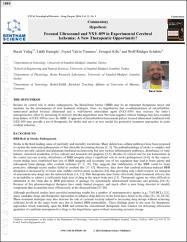| dc.contributor.author | Yuluğ, Burak | |
| dc.contributor.author | Hanoğlu, Lütfü | |
| dc.contributor.author | Yamaner, Feysel Yalçın | |
| dc.contributor.author | Kılıç, Ertuğrul | |
| dc.contributor.author | Schabitz, Wolf Rudiger | |
| dc.date.accessioned | 2020-07-16T09:41:17Z | |
| dc.date.available | 2020-07-16T09:41:17Z | |
| dc.date.issued | 2016 | en_US |
| dc.identifier.citation | Yuluğ, B., Hanoğlu, L., Yamaner, F. Y., Kılıç, E. ve Schabitz, W. R. (2016). Focused ultrasound and NXY-059 in experimental cerebral ischemia: A new therapeutic opportunity? CNS & Neurological Disorders-Drug Targets, 15(9), 1010-1013. https://dx.doi.org/10.2174/187152731509161007122800 | en_US |
| dc.identifier.issn | 1871-5273 | |
| dc.identifier.issn | 1996-3181 | |
| dc.identifier.uri | https://dx.doi.org/10.2174/187152731509161007122800 | |
| dc.identifier.uri | https://hdl.handle.net/20.500.12511/5514 | |
| dc.description.abstract | troke is the third leading cause of morbidity and mortality worldwide. Many deleterious cellular pathways have been proposed to explain the molecular pathogenesis of this clinically devastating disease [1, 2]. The pathophysiology of stroke is complex and involves not only calcium and glutamate-mediated excitotoxicity but also various inflammatory pathways, disturbance of ionic balance, increased production of free radicals and neuronal cell apoptosis [3-5]. Besides its critical role for ion homeostasis in the central nervous system, disturbance of BBB integrity plays a significant role in stroke pathogenesis [6-8]. In this respect, recent studies have established that loss of BBB integrity and secondary loss of ion regulation may lead to brain edema and subsequent brain damage after cerebral ischemia [7, 9, 10]. This suggests that stabilization of the BBB could be brain protective, although recent studies failed to confirm this [11-13]. Moreover, data show that cerebral ischemia-induced BBB disruption is increased by 24 hours after middle cerebral artery occlusion [14], thus providing only a short window for transport of macromolecular drugs into the infarcted brain [14, 15]. This therapeutic time-frame effectively limits treatment efficacy due to an inability to achieve a sufficiently high dose of drug in the target brain area [15]. Therapeutic agents are often difficult to administer to the brain due to BBB prevention of passage for systemically administered molecules and proteins [16-18]. Because of this pharmacological therapies have made limited progress, and much effort is now being directed to identify compounds that accumulate more efficaciously in the diseased brain. | en_US |
| dc.language.iso | eng | en_US |
| dc.publisher | Bentham Science Publishers | en_US |
| dc.rights | info:eu-repo/semantics/openAccess | en_US |
| dc.subject | NXY-059 | en_US |
| dc.subject | Experimental Cerebral Ischemia | en_US |
| dc.subject | Therapeutic Opportunity | en_US |
| dc.title | Focused ultrasound and NXY-059 in experimental cerebral ischemia: A new therapeutic opportunity? | en_US |
| dc.type | editorial | en_US |
| dc.relation.ispartof | CNS & Neurological Disorders-Drug Targets | en_US |
| dc.department | İstanbul Medipol Üniversitesi, Tıp Fakültesi, Dahili Tıp Bilimleri Bölümü, Nöroloji Ana Bilim Dalı | en_US |
| dc.department | İstanbul Medipol Üniversitesi, Mühendislik ve Doğa Bilimleri Fakültesi, Elektrik ve Elektronik Mühendisliği Bölümü | en_US |
| dc.department | İstanbul Medipol Üniversitesi, Tıp Fakültesi, Temel Tıp Bilimleri Bölümü, Fizyoloji Ana Bilim Dalı | en_US |
| dc.authorid | 0000-0002-9704-6173 | en_US |
| dc.authorid | 0000-0003-4292-5717 | en_US |
| dc.authorid | 0000-0003-3841-2943 | en_US |
| dc.authorid | 0000-0001-6494-8923 | en_US |
| dc.identifier.volume | 15 | en_US |
| dc.identifier.issue | 9 | en_US |
| dc.identifier.startpage | 1010 | en_US |
| dc.identifier.endpage | 1013 | en_US |
| dc.relation.publicationcategory | Diğer | en_US |
| dc.identifier.doi | 10.2174/187152731509161007122800 | en_US |
| dc.identifier.wosquality | Q2 | en_US |
| dc.identifier.scopusquality | Q1 | en_US |


















